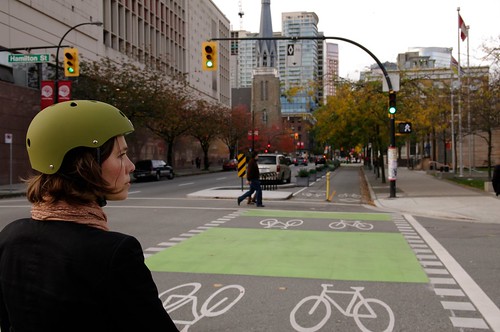
cc licensed ( BY ) flickr photo shared by Paul Krueger
Related Posts:
> See the safety and health category of this blog.
Details:
1. Even in car-centric countries, cycling is not a very dangerous activity and the comparative statistics on fatalities and injuries prove this
- The actual evidence on fatalities, injuries, accidents and overall safety and health demonstrate how safe cycling is. To see just how safe and test how close your perception is to reality, I highly recommend this quiz: > Perceptions of Bicycle Safety
2. Cycling per km has significantly higher fatality and serious injury rates in most car-centric countries
- For example in the United States:
"Dividing 623 deaths into 9,000,000,000, we end up with a cycling fatality rate of about 6.9 per 100 million miles. According to the NHTSA, that same statistic is 1.11 for cars in 2010" > Bicycling: the safest form of transportation- While in the Netherlands, the rate is much lower at around 1 fatality per 100 million miles.
- In Australia one cycling study found the injury rate per km much higher for cyclists:
Based on fatality and serious injury rates per kilometre travelled in Melbourne and Sydney, the relative risk of fatality for cycling compared with driving is between 5 and 19. The relative risk of serious injury for cycling compared with driving in Melbourne is 13 based on police data, and 34 based on hospital data, while the relative risk of all injuries (minor plus serious) is 19 in Sydney based on police data.- However, the reality is that motorists cover a lot more kilometeres than cyclists per year and the correct comparative measure is travel time not distance.
Cycling injuries in Australia: Road safety’s blind spot?
3. Cycling per hour has fatality and serious injury rates comparable to cars (and lower in the safest cycling cities)
- Once you take speed and distance travelled into account, there is little difference in the per hour fatality statistics between bicycles and cars in car-centric countries. In countries/cities which aren't car-centric, the per hour fatality rate will generally be lower than for cars.
Substantially lower cyclist fatality and injury rates in countries such as the Netherlands, Germany and Denmark (compared to Australia, the U.S., U.K.) have been attributed to better cycling infrastructure; national cycling education, skills and promotion programs; widespread traffic calming, including lower speed limits (30km/hr) in urban areas; and driver licensing and road safety systems that place greater responsibility on drivers for the safety of cyclists and pedestrians.4. Walking per km near/on roads has a much higher accident fatality rate than cycling in car-centric countries
Cycling injuries in Australia: Road safety’s blind spot?
- See this video > Is bicycling dangerous - death statistics which implies that there is risk inherent in mixing with cars whatever your form of transport. The per km ratio just reflects that some modes cover less ground. The per hour risk is likely much closer.
5. Cyling is much safer if including the boost to health and longevity from exercise
- Each hour of exercise extends your lifespan by between 3 and 9 hours. (See: CommonHealth, Scientic American). So when this is accounted for, the net benefit for cycling is positive, while the net benefit for driving is still negative:
- General health and quality of life is also much improved from exercise and so (other things being equal) cycling will lead to a much healthier life, less sedentary illnesses, more energy, less obesity, etc."- Net effect of driving a car at 65mph for one hour: Dying 20 minutes sooner. (18 seconds of life lost per mile)- Net effect of riding a bike at 12mph for one hour: Living 2 hours and 36 minutes longer (about 13 minutes of life gained per mile)" > Bicycling: the safest form of transportation
6. Due to individual circumstances and actions, your fatality risk can readily be much lower than national averages, such that cycling is safer than driving
- Essentially the overall driving vs cycling fatality statistics have little relevance to your personal safety and health if making smart cycling choices. You can change your circumstances and make decisions on where and how to ride that make cycling safer than any other form of transport (except possibly walking).
- These individual factors include: living in bike-friendly cities and parts of cities, choosing safe routes, riding safely and defensively, improving your riding skills and being conscious of key cycling risks and how to mitigate them.
See:
> Actual cycling accident history proves how safe it can be
> The most important tips on how to ride safely
Further Info:
Cycling injuries in Australia: Road safety’s blind spot? - by J Garrard, S Greaves & A Ellison
The Urbanist
> Is cycling more dangerous than driving?
> Does cycling on roads put your health at risk?
> Is the risk of getting killed while cycling on roads increasing?
> Time for government to act on crazy cocktail of bicycles and cars





